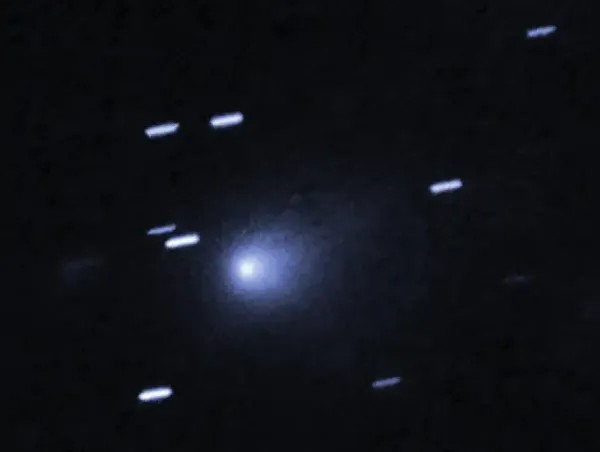The interstellar comet 3I/ATLAS racing through our solar system has been caught unexpectedly picking up speed as it moves away from the sun and closer toward Earth. According to a report in IFL Science, new observations of visitor 3I/ATLAS have shown that our interstellar comet may have lost a significant amount of mass following its close encounter with the Sun. On July 1, astronomers at the Asteroid Terrestrial-impact Last Alert System (ATLAS) spotted an object zipping its way through our Solar System at high speeds. Follow-up observations showed that it was on an escape trajectory. With an eccentricity greater than 1, it was determined to be an interstellar visitor, the third we have spotted so far after 1I/ʻOumuamua and 2I/Borisov.
ALSO READ: Zohran Mamdani, who won New York City mayor’s race, secretly tied the knot in exotic Dubai ceremony with Rama Duwaji? What we know
While NASA believes the sun's gravity is mainly responsible for the speed boost, scientists are having a harder time figuring out what has caused 3I/ATLAS to noticeably shift away from our home star. On the other hand, Harvard physicist Avi Loeb has revealed that astronomers are still awaiting evidence that 3I/ATLAS has released anywhere close to enough gas to prove the object is really a comet.
The latest observation from October 31 to November 4, reveal that the interstellar comet 3I/ATLAS has likely lost a significant amount of mass during its encounter with our host star. It has also changed course slightly, undergoing non-gravitational acceleration, or acceleration not accounted for by gravity alone.
ALSO READ: Jay Jones wins Virginia's race for attorney general despite texts fantasizing about killing Republican lawmaker, family
As explained by Harvard astronomer Avi Loeb in a blog post, 3I/ATLAS has undergone a "radial acceleration away from the Sun of 1.1x10^{-6} au per day squared", as well as a "transverse acceleration relative to the Sun’s direction of 3.7x10^{-7} au per day squared".
As comets are heated, they lose mass by outgassing, where the volatile ices on their surface vaporize, and conservation of momentum tells us the object undergoes a resulting acceleration.
"The reported non-gravitational acceleration amounts to 94 kilometers per day squared at perihelion. These values combine to imply that 3I/ATLAS lost a fraction of its mass equal to: ~13% divided by v in units of 300 meters per second, where a value of v~300 meters per second corresponds to the characteristic thermal speed of molecules at the surface temperature of 3I/ATLAS near perihelion," Loeb writes.
"This ejection speed would be the maximum expected value for a natural comet, thus implying that 3I/ATLAS must have lost more than 13% of its mass near perihelion in the natural scenario."
ALSO READ: Will million New Yorkers flee the city after Zohran Mamdani wins NYC mayoral election? What alarming poll shows
Amid growing public intrigue over interstellar comet 3I/ATLAS, mounting pressure is being placed on Nasa to release high-resolution images of the comet captured during its closest approach to Mars. Congresswoman Anna Paulina Luna has formally requested Nasa to make available the imagery, highlighting the intense curiosity surrounding this enigmatic visitor from beyond our solar system.
ALSO READ: Zohran Mamdani, who won New York City mayor’s race, secretly tied the knot in exotic Dubai ceremony with Rama Duwaji? What we know
NASA detects bizarre boost in comet 3I/ATLAS's speed
NASA has confirmed a small extra 'kick' moving the mysterious visitor dubbed 3I/ATLAS off its predicted path, which can't be explained by the sun's gravity. The object, which many scientists claim is a comet, set a record as the fastest space rock entering the solar system ever detected by humans at more than 130,000mph. After reaching its closest point to the sun on October 29, known as perihelion, its speed has now soared to approximately 152,000mph.While NASA believes the sun's gravity is mainly responsible for the speed boost, scientists are having a harder time figuring out what has caused 3I/ATLAS to noticeably shift away from our home star. On the other hand, Harvard physicist Avi Loeb has revealed that astronomers are still awaiting evidence that 3I/ATLAS has released anywhere close to enough gas to prove the object is really a comet.
The latest observation from October 31 to November 4, reveal that the interstellar comet 3I/ATLAS has likely lost a significant amount of mass during its encounter with our host star. It has also changed course slightly, undergoing non-gravitational acceleration, or acceleration not accounted for by gravity alone.
ALSO READ: Jay Jones wins Virginia's race for attorney general despite texts fantasizing about killing Republican lawmaker, family
As explained by Harvard astronomer Avi Loeb in a blog post, 3I/ATLAS has undergone a "radial acceleration away from the Sun of 1.1x10^{-6} au per day squared", as well as a "transverse acceleration relative to the Sun’s direction of 3.7x10^{-7} au per day squared".
As comets are heated, they lose mass by outgassing, where the volatile ices on their surface vaporize, and conservation of momentum tells us the object undergoes a resulting acceleration.
"The reported non-gravitational acceleration amounts to 94 kilometers per day squared at perihelion. These values combine to imply that 3I/ATLAS lost a fraction of its mass equal to: ~13% divided by v in units of 300 meters per second, where a value of v~300 meters per second corresponds to the characteristic thermal speed of molecules at the surface temperature of 3I/ATLAS near perihelion," Loeb writes.
"This ejection speed would be the maximum expected value for a natural comet, thus implying that 3I/ATLAS must have lost more than 13% of its mass near perihelion in the natural scenario."
ALSO READ: Will million New Yorkers flee the city after Zohran Mamdani wins NYC mayoral election? What alarming poll shows
When will interstellar comet reach Earth?
3I/ATLAS is now just six weeks from reaching its closest point to Earth, and Loeb added that not detecting a cloud of gas coming from the object would be a clear sign that this latest speed boost was powered by an extraterrestrial rocket engine. NASA's latest readings found the mystery push got significantly weaker in the days after 3I/ATLAS reached its perihelion with the sun, but it was still noticeable and unrelated to the star's gravitational pull.Amid growing public intrigue over interstellar comet 3I/ATLAS, mounting pressure is being placed on Nasa to release high-resolution images of the comet captured during its closest approach to Mars. Congresswoman Anna Paulina Luna has formally requested Nasa to make available the imagery, highlighting the intense curiosity surrounding this enigmatic visitor from beyond our solar system.








